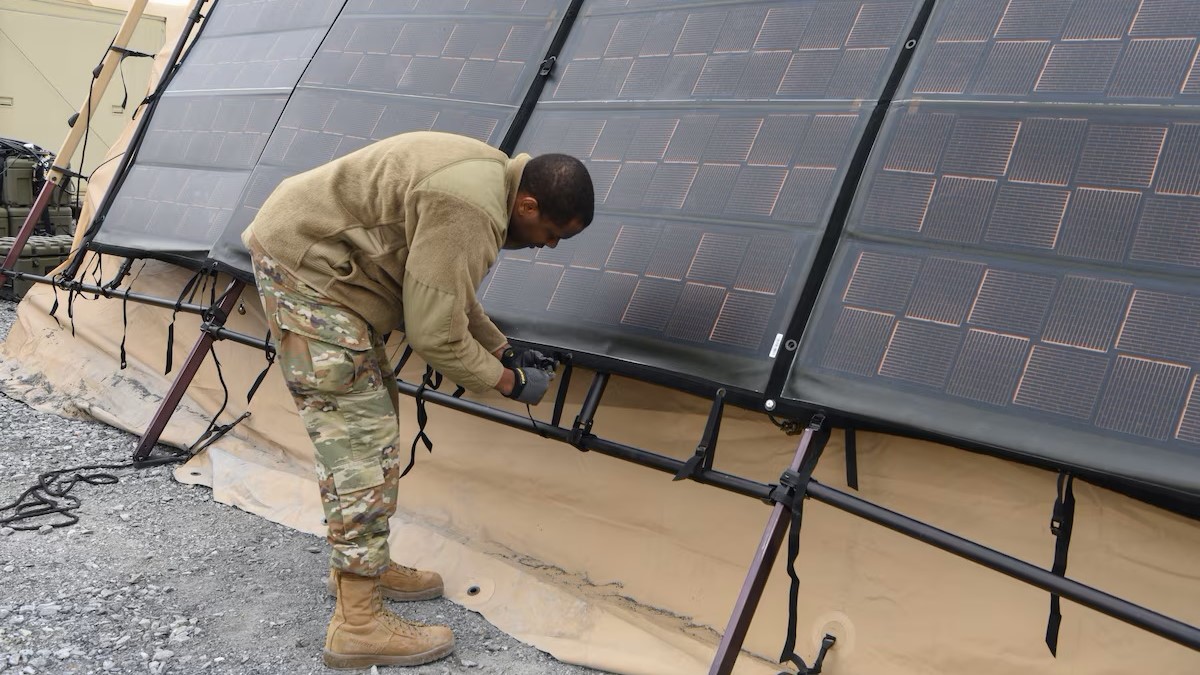April 07, 2025 | By Air Force Surgeon General Public Affairs
FALLS CHURCH, Va. — As the U.S. Air Force Medical Command presses ahead with the modernization of its medical capabilities, its priorities remain clear: ensuring mobility, adaptability, and sustainability in patient care across a range of operational settings. A recent round of field testing at Fort Detrick, Maryland, underscored this commitment, with AFMEDCOM’s Capability Development Division spearheading efforts to assess cutting-edge technologies aimed at enhancing expeditionary medical support. At the helm was A5T, the division’s operational test branch, which convened a cadre of subject matter experts to evaluate two promising innovations: the Silent Tactical Energy Enhanced Dismount, a transport system designed to improve battlefield mobility, and a solar canopy system tailored for remote medical operations. These trials signal a broader push to equip frontline medical teams with the tools needed to operate effectively in austere and unpredictable environments.
Need for STEED: A Game changer for patient ground transport
In the unforgiving landscapes of high-intensity combat, the speed and efficiency of patient transport can mean the difference between survival and tragedy. With this in mind, the Pacific Air Forces have sought a more advanced solution for casualty evacuation - one capable of navigating treacherous terrain while easing the physical burden on medics. The answer may lie in STEED, a rugged, all-terrain, solar-electric cart designed to enhance mobility and reduce the risk of musculoskeletal injuries during evacuations. By marrying durability with innovation, PACAF hopes this heavy-payload vehicle will offer a crucial advantage in the race against time on the battlefield.
A five-person team of military health professionals, led by U.S. Air Force Lt. Col. Alexander Ford, executed a 15-mile endurance test at Greenbrier State Park, Maryland, simulating a casualty transport scenario. “We’re always looking ahead to tomorrow’s battlefield and how we can speed up patient transport,” said Ford. “Moving a casualty and equipment weighing up to 300 pounds across rough terrain in an austere environment, allowing our teams to focus on delivering care instead of struggling with patient movement, is critical to saving lives."
The test evaluated STEED's performance across variable terrains, inclines, and climate conditions, ensuring the system meets PACAF's standards for agile casualty evacuation in austere environments.
Solar canopy: Powering remote medical operations
As expeditionary medical teams extend their reach into contested environments, securing reliable and adaptable power sources has become a strategic imperative. AFMEDCOM is addressing this challenge by trialing a solar canopy system designed to sustain mobile medical units with a dependable and renewable energy supply.
AFMEDCOM’s A5T test team recently conducted manufacturer training and system integration at Fort Detrick, pairing the solar canopy with TM-60 medical tentage. Engineered to operate primarily on solar power, with a traditional generator as backup, the system promises sustained energy independence while reducing reliance on traditional base operating support.
This dual-power approach dovetails with the Agile Combat Employment model, which aims to enhance the resilience of "spoke" medical units operating across the vast PACAF and Indo-Pacific Command areas of responsibility. By supplementing existing energy sources, the solar canopy could prove critical in powering life-saving medical equipment - including ventilators, monitors, sterilizers, and blood storage units - where conventional infrastructure is scarce or non-existent. If successful, such innovations could redefine battlefield medicine, ensuring that care remains uninterrupted even in the most austere conditions.
Shaping the future of expeditionary medical care
AFMEDCOM’s test and evaluation efforts play a vital role in ensuring that both the U.S. Air Force and Space Force are equipped with the most effective tools to support warfighters across any operational theater. The integration of technologies such as the STEED all-terrain transport system and solar canopy power solutions underscores the military’s relentless drive to enhance medical mobility and adaptability. These innovations reflect the broader commitment of the Air Force Medical Service to delivering life-saving care - anytime, anywhere - while reinforcing the resilience and self-sufficiency required for modern expeditionary medicine. In an era of increasingly complex conflicts, such advancements are not merely desirable but essential.



